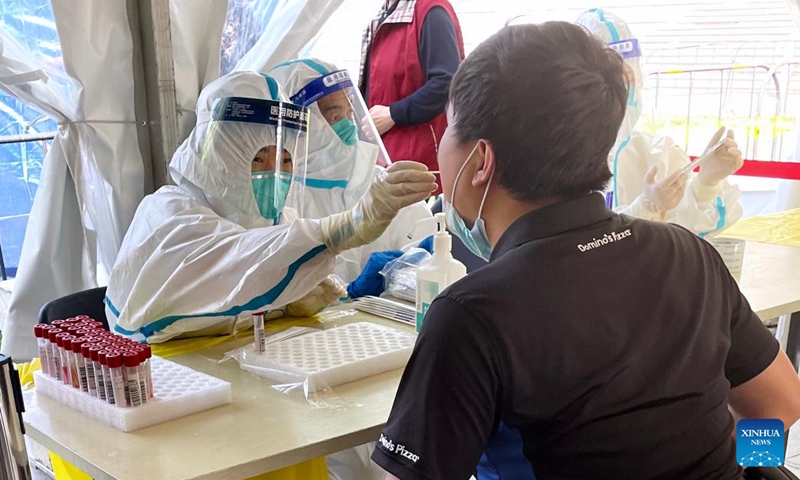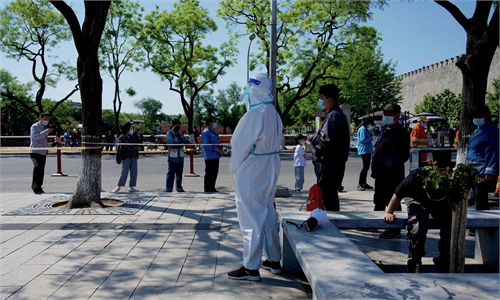Beijing’s Chaoyang district asks residents to work from home from Thursday amid fresh flare-up

A medical worker takes a swab sample from a resident for a nucleic acid test in Haidian District, Beijing, capital of China, May 3, 2022. Beijing's 12 districts have started three rounds of nucleic acid screening from Tuesday till Thursday on a daily basis in succession to curb the COVID-19 resurgence. (Xinhua)
Residents in Beijing's most populous Chaoyang district have to start working from home on Thursday, and those who must work in their offices are advised to travel by themselves and reduce gatherings at companies, the Beijing government announced on Wednesday, following its fresh COVID-19 flare-up that has seen over 500 infections since the end of April.Beijing on Wednesday also adjusted its quarantine policy for close contacts of COVID-19 cases and international travelers entering the capital due to the features of the Omicron variant.
At Wednesday's media briefing, Xu Hejian, spokesperson of the Beijing municipal government, said that the total cases in the fresh wave of the epidemic in the capital had exceeded the number reported in cluster infections in the Xinfadi wholesale market in 2020.
The Xinfadi outbreak was the worst epidemic in the capital in the past two years. It was put under control in 40 days with a total case number of 335. Beijing reported 52 new cases from Tuesday afternoon to Wednesday afternoon, bringing the tally to 505 cases since April 22.
Xu said that Beijing's daily new cases have been reported at around 50 for days, and there were still several cases reported in communities, indicating that the capital's epidemic prevention and control situations were still grim.
Xu said that Beijing will continue its epidemic measures after the May Day holidays ended on Wednesday, with all restaurants suspending dining-in services.
Residents in Chaoyang district, which has reported most of the cases, have to work from home from Thursday, and those who have to go to their offices need to travel by themselves and ensure they only commute from their homes to their offices, Xu said.
Online ride-hailing platforms have to reduce dispatching vehicles to areas under closed management, the Beijing government said.
Xu said that close contacts of COVID-19 cases will have to undergo 10 days of centralized quarantine and seven days of home quarantine, instead of the previous 21-day centralized quarantine.
Other at-risk groups should undergo seven days of home quarantine or 10 days of home quarantine with seven days of health monitoring. During quarantine, these people should receive nucleic acid testing and antigen testing.
Due to the short incubation period and mild clinical symptoms of the Omicron variant, Beijing on Wednesday adjusted the quarantine policy for international travelers entering Beijing.
Those who entered Beijing through the Beijing port have to undergo 10 days of centralized quarantine and seven days of home quarantine, and those who entered Beijing through other Chinese cities are allowed to enter the capital after 14 days of quarantine in the entry cities. Otherwise, they are not allowed to enter Beijing.
Beijing announced it would conduct three more rounds of district-wide nucleic acid testing from Tuesday for 12 districts, and the first round of testing collected samples from 19.9 million people, and three tubes which mixed 10 samples in one tube tested positive, Xu said.
Beijing has conducted several rounds of district-wide nucleic acid testing since April 25, and has basically figured out the hidden community transmissions, Xu said.
Global Times

